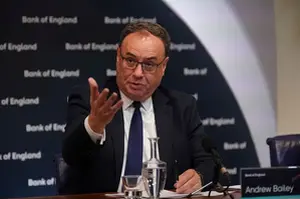
A year later, the Fed still has a long way to go in the fight against inflation
It was a year ago this month that the Federal Reserve launched its first attack against inflation that had been percolating in the U.S. economy for at least the previous year.
That first strike, in retrospect, would seem timid: Just a quarter percentage point increase to tackle price surges which in just a few months would peak at their highest annual rate since late 1981. It wouldn't be long before policymakers knew that initial step wouldn't be enough.
Subsequent months saw much larger hikes, enough to raise the Fed's benchmark borrowing rate by 4.5 percentage points to its highest since 2007.
So after a year of inflation fighting, how are things going?
In short, OK, but not a whole lot more.
The rate hikes appeared to have quelled some of the inflation surge that inspired the policy tightening. But the notion that the Fed was too late to get started lingers, and questions are increasing over how long it will take the central bank to get back to its 2% inflation standard.
"They have a ways to go," said Quincy Krosby, chief global strategist for LPL Financial. "It took them a long time to acknowledge that inflation was stickier than they initially assessed."
Indeed, Fed officials for months stuck to the narrative that inflation was "transitory" and would abate on its own. In the interim, prices soared, wages increased but failed to keep up, and central bankers were left with a public impression that they were asleep at the switch while an economic crisis raged.
A Gallup poll in late 2022 showed that just 37% of the public had a favorable impression of the Fed, which not so long ago was one of the most trusted public agencies around.
"This is not to criticize them, but to understand: They do not know more about inflation than the average consumer. That's important," Krosby said. "It's just that, it's their job to know. And that's where the criticism comes in."
That criticism has come amid some staggering inflation data.
Energy prices at one point last summer were up more than 41% in a 12-month span. Food inflation peaked out over 11%. Prices of individual items such as eggs, airline fares and pet food saw stratospheric increases.
Fed Chairman Jerome Powell recently insisted that he and his colleagues are taking "forceful steps" now to bring down inflation. Powell and other Fed officials almost universally have acknowledged they were slow to recognize the durability of inflation, but they are acting appropriately to address the problem now.
"It would be very premature to declare victory or to think that we've really got this," Powell added at a Feb. 1 news conference. "Our goal, of course, is to bring inflation down."
Some signs of progress
Inflation is a mosaic of many indicators. At least recently, there have been signs that one of the more closely watched gauges, the Labor Department's consumer price index, is at least heading in the right direction. The index most recently showed an annual inflation rate of 6.4%, down from a peak around 9% in the summer of 2022.
The personal consumption expenditures price index, which is more closely watched by the Fed as it adjusts more rapidly to swings in consumer behavior, also has been drifting lower, to 5.4% annually, and is getting closer to the CPI.
But with inflation still well above the Fed target, there's growing concern in the financial markets that more interest rate hikes will be needed, even more than central bank officials anticipate. The rate-setting Federal Open Market Committee in recent months has reduced the level of rate hikes, from four consecutive three-quarter point increases to a half-point hike in December and a quarter-point move in early February.
"They slowed [the pace of hikes] prematurely. We're just at the starting gate of their policy moves biting," said Steven Blitz, chief U.S. economist at TS Lombard. "They started in baby steps, which really was reflective of how far behind they were in getting rates to where they would even begin to bite."
Another big market fear is that the Fed will cause a recession with its rate hikes, which have taken the benchmark overnight borrowing rate to a range between 4.5% and 4.75%. Markets figure the Fed will take that rate up to a range between 5.25%-5.5% before stopping, according to futures trading data.
But Blitz said a mild recession might be the best case.
"If we don't get recession, we're going to be at a 6% funds rate by the end of the year," he said. "If we do get recession … we'll be in a 3% funds rate by the end."
Still growing
Thus far, though, a recession looks at the very least not a threat in the near term. The Atlanta Fed is tracking gross domestic product growth of 2.3% for the first quarter, just ahead of the 2.7% level in the fourth quarter of 2022.
Fed moves have hit hardest for the more rate-sensitive sectors of the economy. Housing has pulled back from its nosebleed heights early in the Covid pandemic, while Silicon Valley also has been hammered by higher costs and pushed into a painful round of layoffs after over-hiring.
But the larger jobs market has been stunningly resilient, posting an unemployment rate of 3.4% that is tied for the lowest since 1953, after a January burst that saw nonfarm payrolls grow by 517,000.
The wide gap between job openings and available workers is one reason economists think the U.S. could avoid a recession this year.
There are, though, trouble spots: While housing is mired in a prolonged slump, manufacturing has been in contraction for the past three months. Those conditions are consistent with what some economists have called "rolling recessions," in which the entire economy doesn't contract but individual sectors do.
Consumers, though, remain strong, with retail sales popping 3% in January as shoppers put accumulated savings to work, keeping restaurants and bars packed and boosting online sales.
While that's good news to those wanting to see the economy buoyant, it's not necessarily pleasant for a Fed purposely trying to slow the economy so it can bring inflation under control.
Citigroup economist Andrew Hollenhorst thinks the Fed could tame key inflation metrics to around 4% by the end of this year. That would be better than the latest core CPI of 5.6% and core PCE of 4.7%, but still a good distance from target.
Recent stronger-than-expected readings for both gauges show the risk is to the upside, he added.
A decline "should keep Fed officials focused on slowing the economy sufficiently to reduce inflationary pressure," Hollenhorst wrote in a client note this week. "But the activity data are also not cooperating."
Goldman Sachs also is confident inflation will fall over the next month. But "but some news over the last month has made the near-term outlook appear more challenging," Goldman economist Ronnie Walker wrote.
Walker notes that goods prices for items such as used cars have been rising rapidly. He also estimated that "super-core" inflation — a measure that Chairman Powell has spoken of lately which excludes food, energy and housing costs — probably will hold around 4%.
Taken together, the data suggest that "the balance of risks to our forecast" for the Fed's key interest rate are "tilted to the upside," Walker wrote.
Looser conditions
One confounding part of the Fed's efforts is that policy moves are supposed to work through "financial conditions" — an amalgam of indicators covering everything from bond yield spreads to stock market moves to mortgage rates and other far more arcane measures.
The Chicago Fed has a tracker that provides a good gauge on which direction things are heading. Interestingly, even though the Fed has continued to tighten policy, the Chicago index actually has eased since October, helping exemplify the challenge to calibrate policy with conditions on the ground. (Measures above zero represent tightening, while those below zero show looser conditions.)
It's particularly confounding in that Powell said at the Feb. 1 news conference that conditions "have tightened very significantly" since the rate hikes began.
Despite the struggles to change the flow of inflation, Minneapolis Fed President Neel Kashkari said Wednesday he sees evidence that policy is working.
However, he acknowledged there's more work ahead.
"Real rates are positive across the curve, all of which suggests to me that our policy is having the desired effect of tapping the brakes on the economy," Kashkari said during an event in Sioux Falls, S.D.
"But I am conscious of, hey, if we declare victory too soon, there is going to be this flood of exuberance and then we're going to have to do even more work to bring that back down," he added. "So we're going to continue doing what we're doing until we finish the jobs, and I'm committed to doing that."






